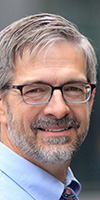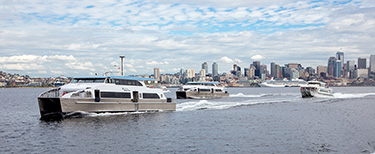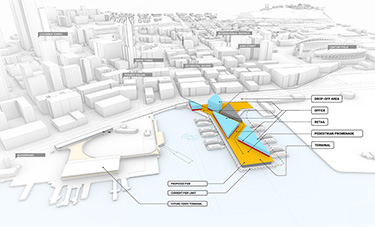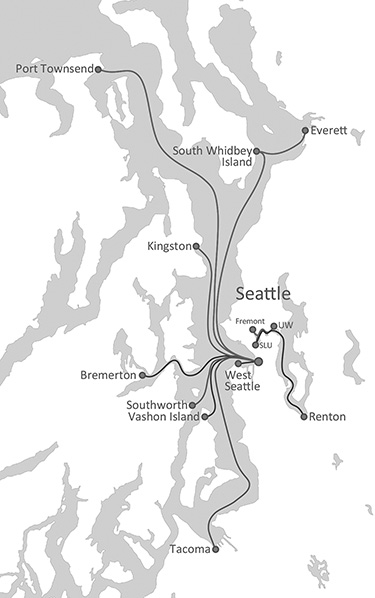|
Subscribe / Renew |
|
|
Contact Us |
|
| ► Subscribe to our Free Weekly Newsletter | |
| home | Welcome, sign in or click here to subscribe. | login |
Construction
| |
 |
February 28, 2019
Future commute? Look to our waterways
KPFF Consulting Engineers

Bennett
|
Growing demand for transportation alternatives is driving increased interest across the country in waterborne transportation. The Puget Sound region is no exception and is poised to take advantage of our local waterways to move people from waterfront communities to growing job centers in downtown Seattle and South Lake Union.
Pier 48 presents an ideal opportunity to develop a new mixed-use, multi-modal passenger-only ferry terminal connecting these services to the new Seattle waterfront.
Since the first Native Americans traveled between villages by canoe, the waterborne transportation of people has shaped coastal development on Puget Sound. With the Washington State Ferries 2040 Long Range Plan predicting ridership growth of over 30 percent in the next 20 years, the movement of people across our shores will continue to influence our waterfronts and transportation networks for years to come.
In addition to growth on WSF’s large ferries, new passenger-only routes are being studied, planned and operated up and down Puget Sound, as well as on Lake Washington and Lake Union. This new version of the historic Mosquito Fleet will bring the benefits of marine transit to cities that have not had ferry service in decades.
Growing demand for transportation alternatives and advanced vessel technology that reduces fuel consumption and greenhouse gas emissions make these new services feasible; the major remaining obstacle is finding a place to land on Seattle’s Central Waterfront.
Central Sound terminal upgrades
The two largest ferry-related developments in the central sound are being undertaken by WSF in downtown Seattle and Mukilteo, with the creation of new multimodal hubs to serve the busiest routes in the WSF system.
At downtown Seattle’s Colman Dock, a new terminal on a seismically upgraded pier will serve WSF ferries, which brought over 9 million walk-on and vehicle passengers into downtown from Bremerton and Bainbridge Island in 2018. Other terminal improvements under construction include an overhead walkway connecting the main terminal to the adjacent passenger-only terminal, improved passenger amenities, and a new footbridge over Alaskan Way on Marion Street.
Adjacent to the new terminal building at Colman Dock, Pier 50 is being rebuilt to serve passenger-only ferries operated by King County Metro and Kitsap Transit arriving from West Seattle, Vashon Island, Bremerton and Kingston, with new service from Southworth scheduled to start in 2020.
In Mukilteo, a short walk to the northeast of the existing ferry landing, a new WSF terminal will open the heart of the downtown waterfront to new development, reduce backups on state Route 525, and provide a new overhead passenger loading system.
The new terminal is also closer to Sound Transit’s Mukilteo Station and includes a new transit center for Sound Transit, Community Transit and Everett Transit buses. These multimodal connections will make it easier for Whidbey Islanders to reach jobs on the east side of Puget Sound without the need to drive onto a ferry.
Looking ahead, WSF is planning to rebuild or replace the Fauntleroy ferry terminal in West Seattle, with the intent of improving reliability of the service and reducing the impact of ferry operations on the surrounding community. As this terminal serves riders from Vashon Island and Southworth, it is key to improving service on the “triangle route,” one of the most challenging services in the WSF system.
Foot ferries on Puget Sound
The West Seattle Water Taxi is a vital transportation link between Seacrest Park and downtown Seattle, with ridership increasing every year. Looking ahead, the taxis will be counted on to provide reliable service throughout Seattle’s period of maximum constraint.
In 2016, voters in Kitsap County passed a sales tax to pay for new high-speed passenger-only ferry service to downtown Seattle from Bremerton, Kingston and Southworth. Currently operating Bremerton and Kingston passenger-only ferries are meeting or exceeding ridership projections. New boats will be built for the new route to Southworth, as well as to provide backup vessels critical to reliable service.
Home values in Bremerton are already seeing the impact of the new ferries, which provide a 30-minute commute to downtown Seattle. The direct connection to jobs in downtown Seattle is also expected to draw commuters to Kingston and Southworth, where the cost of living is much lower than in King County.
Additional services are in the planning and feasibility study phase, starting with the recently completed Tacoma Feasibility Study, which identified a reliable 55-minute commute from downtown Tacoma to downtown Seattle using 150-passenger vessels. Discussions are underway in the North Sound on potential passenger-only services between Langley and Everett and — if successful — expanded service from Clinton to Seattle, as well as service between Bellingham and the San Juan Islands.
Foot ferries on lakes
On fresh water, private interests are planning to connect high-tech jobs in Renton and South Lake Union, using advanced high-speed ferries running at 35-plus knots on Lake Washington to make the trip in less than an hour. An independent but complementary service on Lake Union is planned to launch in 2020, connecting Lake Union Park with the University of Washington and Fremont using all-electric ferries designed to carry 30 passengers and bicycles.
Pier 48 multi-modal hub
While passenger-only ferries help achieve the city of Seattle’s goals of providing transportation alternatives and reducing the number of private vehicles coming into downtown, the greatest challenge to the growth of these services is the lack of a place to land. The new Pier 50 will initially have two slips, and while talks are underway to increase that capacity, even more slips will be needed as new ferry services are launched.
An ideal site for an expanded passenger ferry hub is Pier 48, which is owned by WSDOT and is being used as a staging area for Colman Dock and the demolition of the Alaskan Way Viaduct.
Using the Ferry Building in San Francisco as an example of a successful mixed-use, transit-oriented waterfront development, a rebuilt Pier 48 could be home to restaurants, retail, offices and public open spaces — all built around its core function as a multi-modal transportation hub. Its proximity to historic Pioneer Square and the Stadium District would bring in both tourists and fans of the Seattle Sounders, Mariners and Seahawks.
The Central Puget Sound region is seeing rapid growth in east-west ferry service and new north-south routes can be expected to add options for travelers to and from downtown Seattle. These services are already driving development opportunities in their originating communities and they need partners in Seattle to overcome the challenges associated with development of sites like Pier 48.
Working together, the public and private sectors could create a modern, efficient multimodal transportation center at Pier 48 that would energize the south end of the Central Waterfront with commuters, tourists, residents and sports fans — seven days a week and well into the future.
Andrew Bennett, a principal in the Waterfront and Heavy Civil Engineering Group at KPFF Consulting Engineers, is a naval architect, waterborne transit planner, and waterfront project manager who rides ferries whenever he gets the chance.
Other Stories:
- Connecting a waterfront landmark back to the city
- Here’s Seattle’s chance to set the bar for civic space
- A gathering place for all on Edmonds’ shoreline
- Waterfront Park fits how Seattle lives, works
- New law gets downtown Bremerton back on track
- Old industrial area becomes a destination along the Columbia





